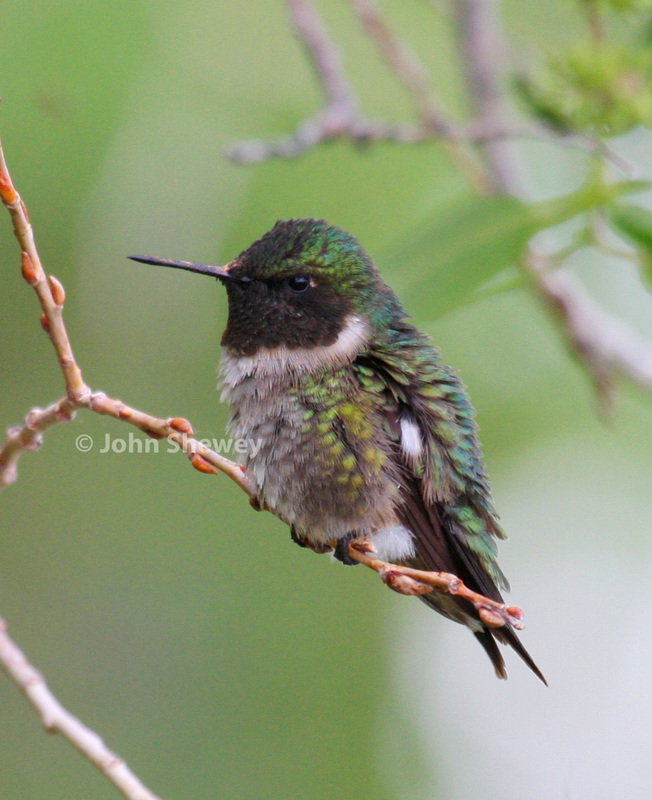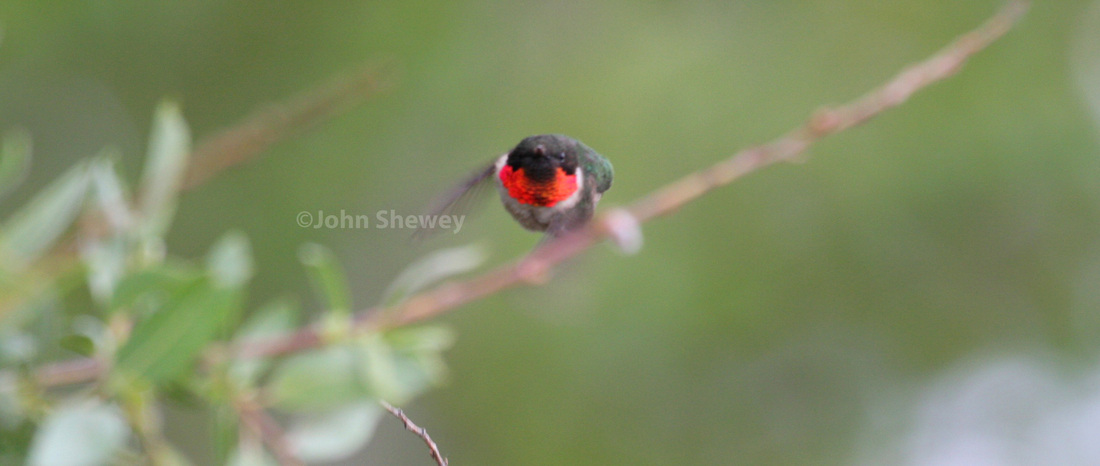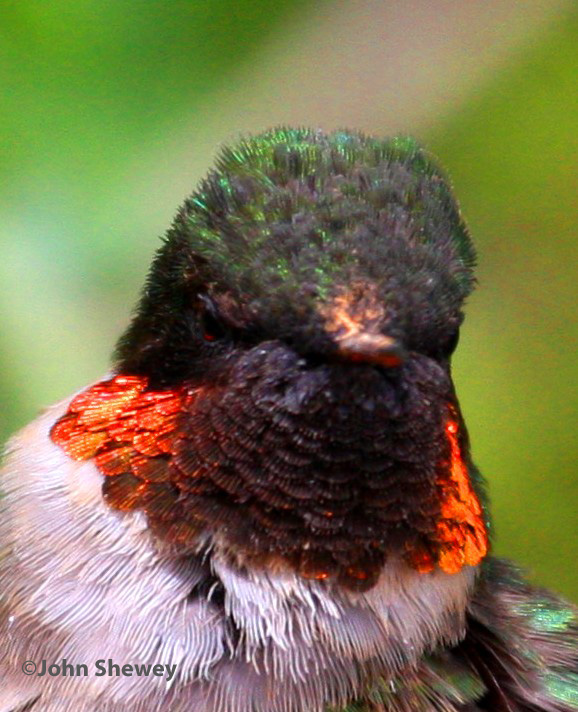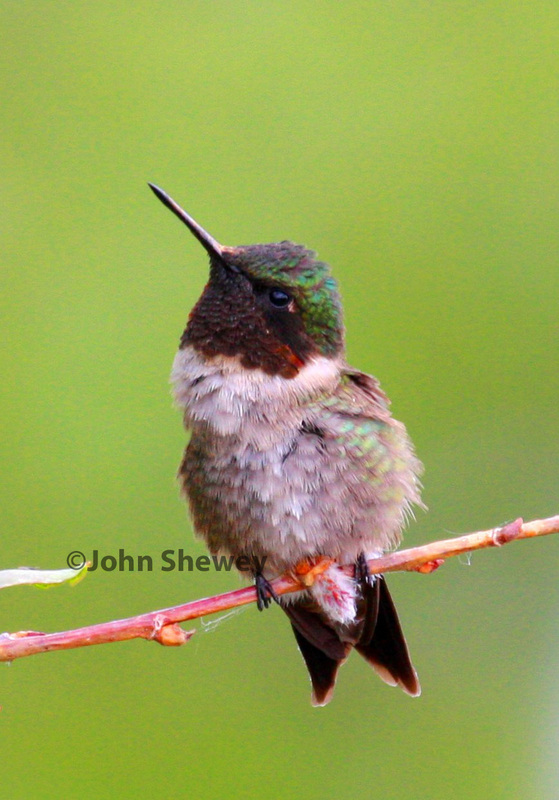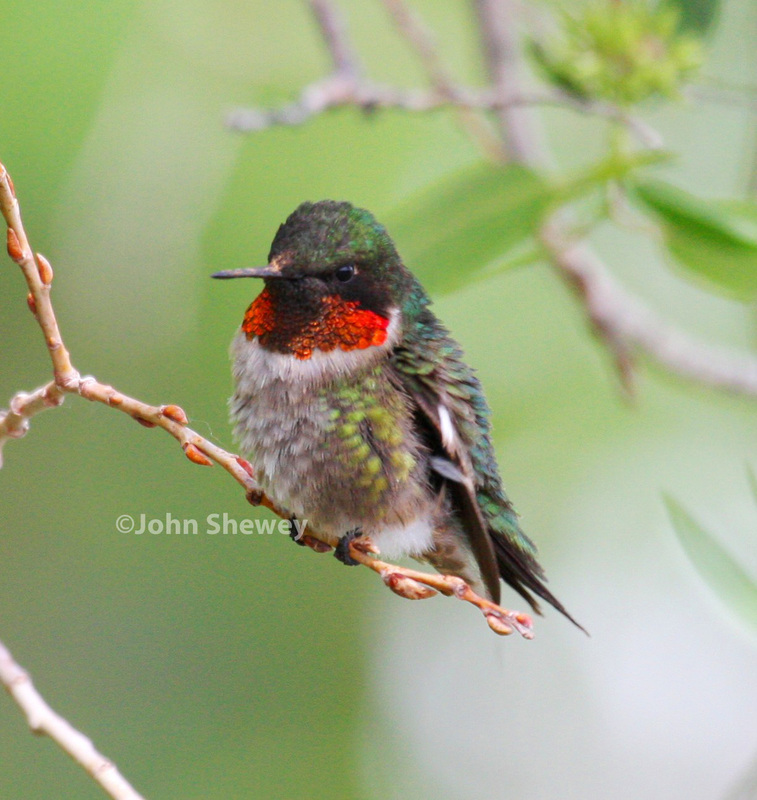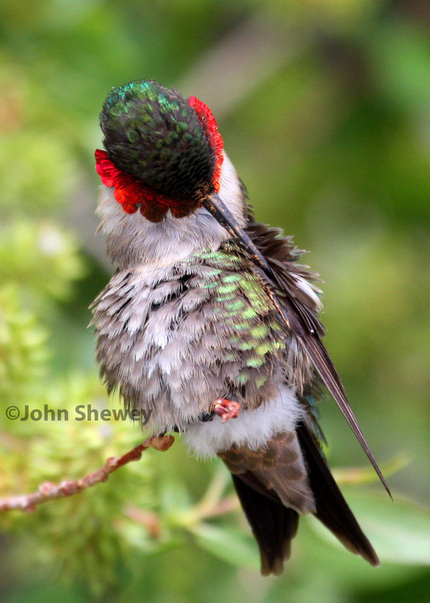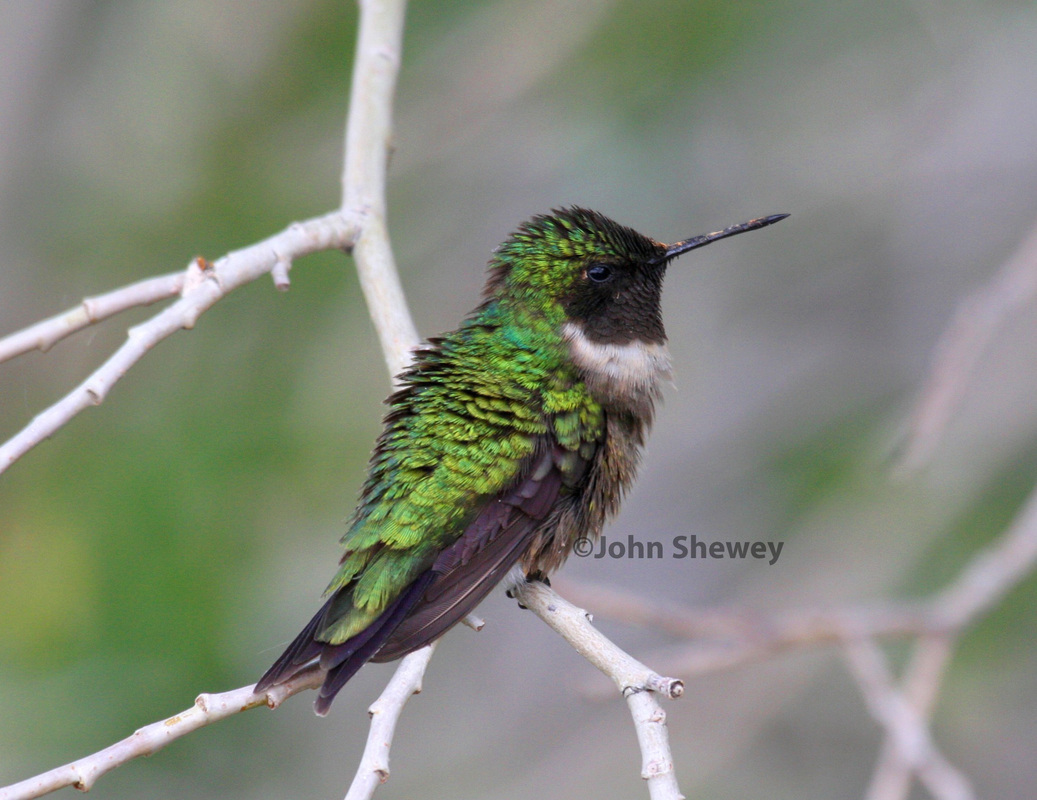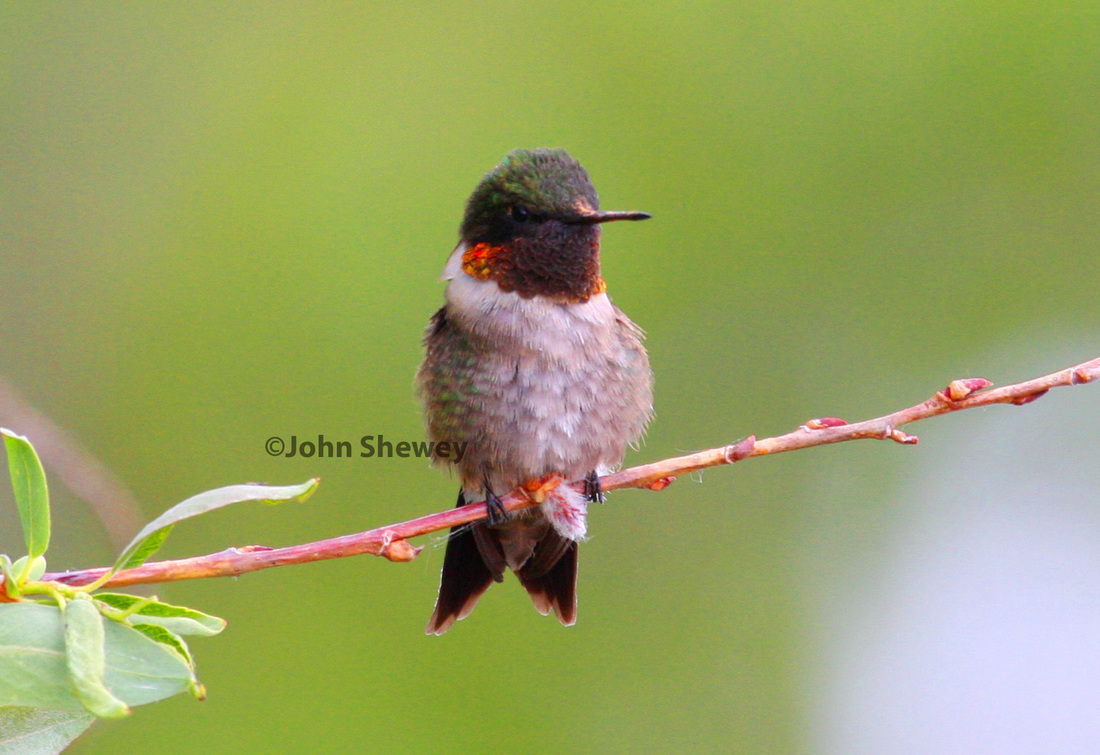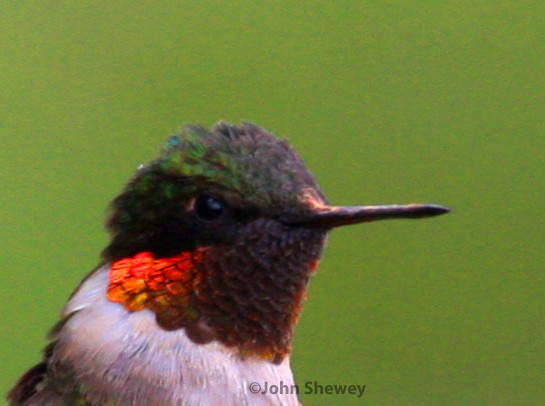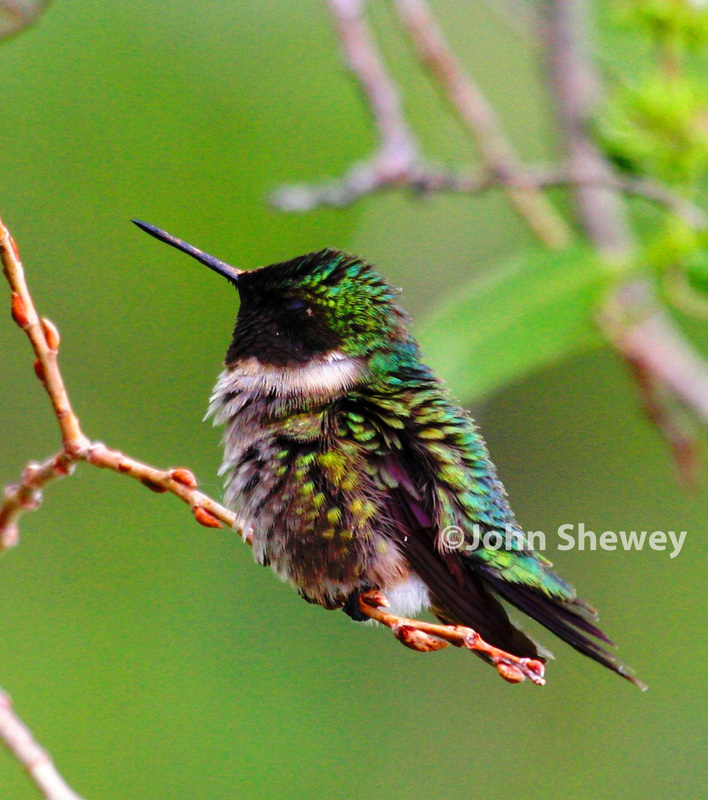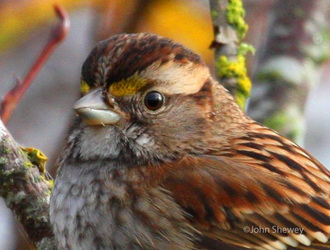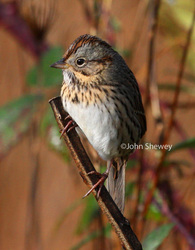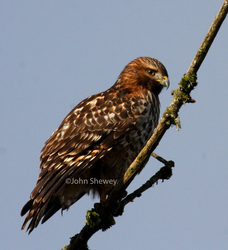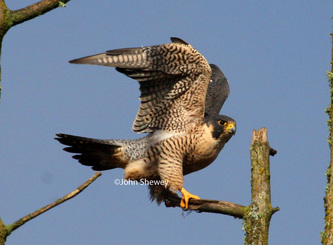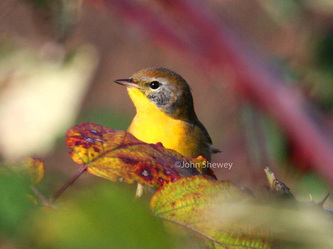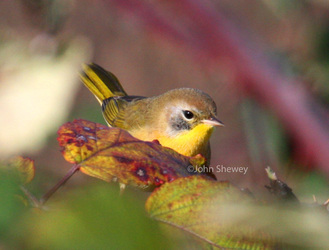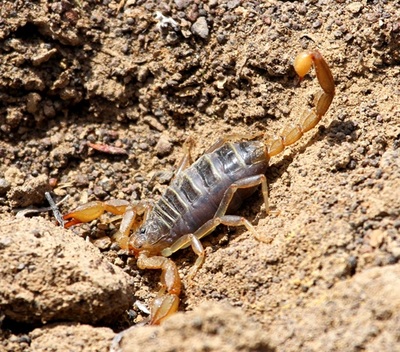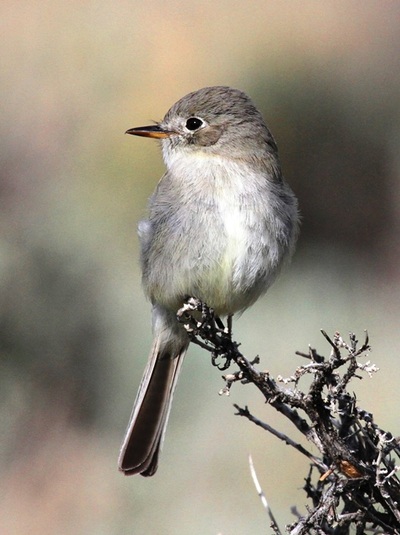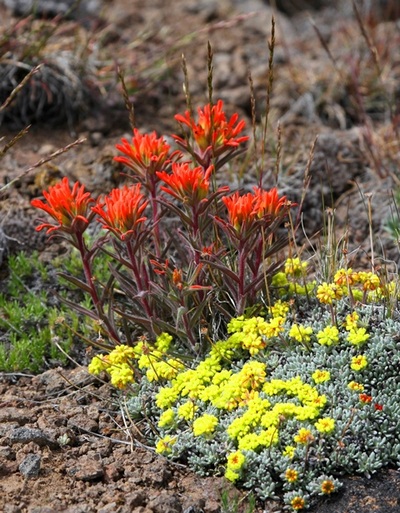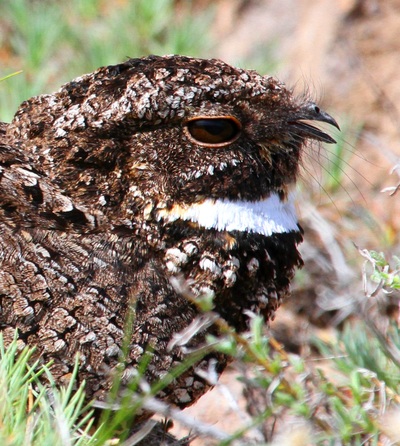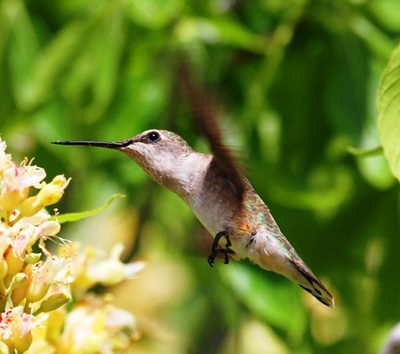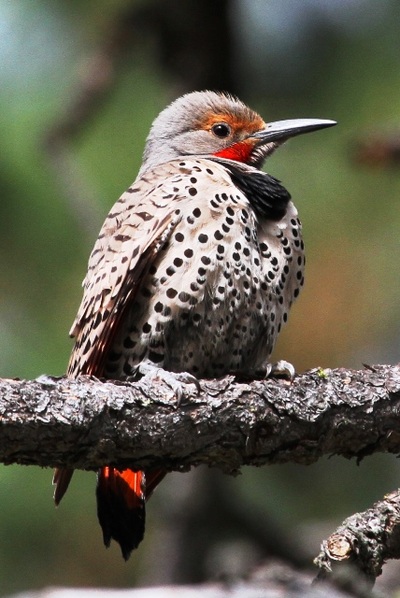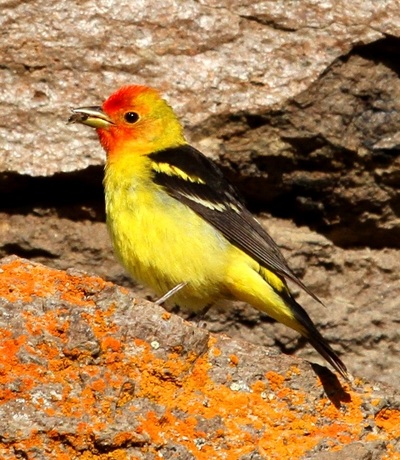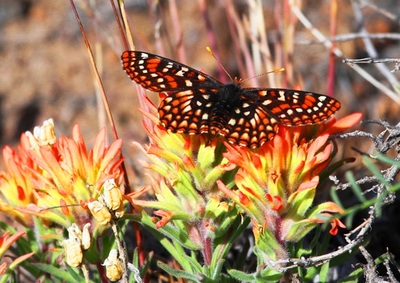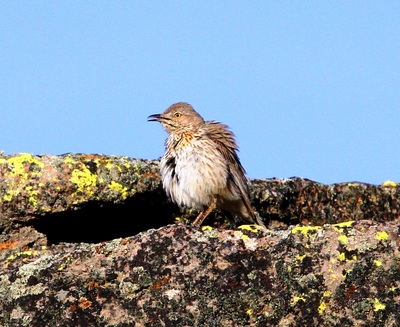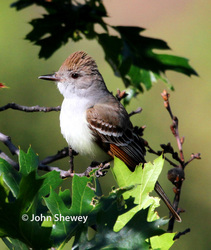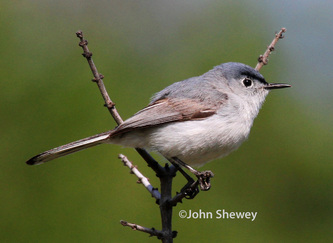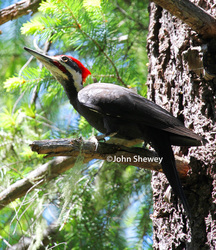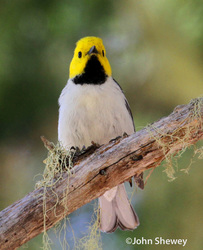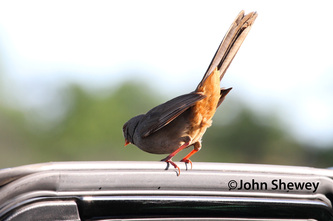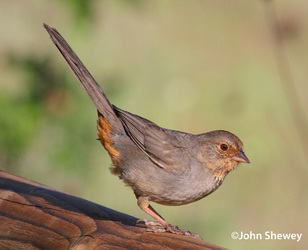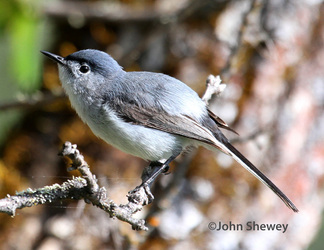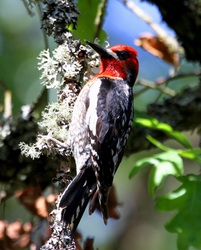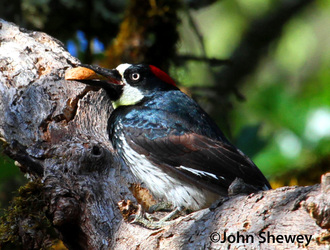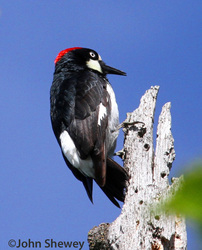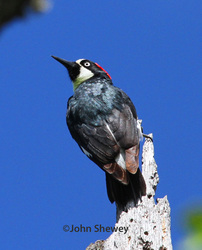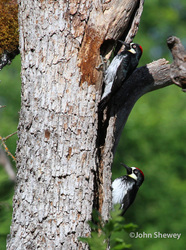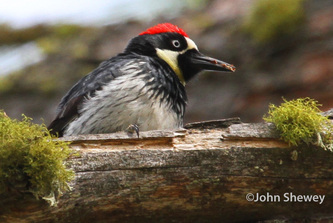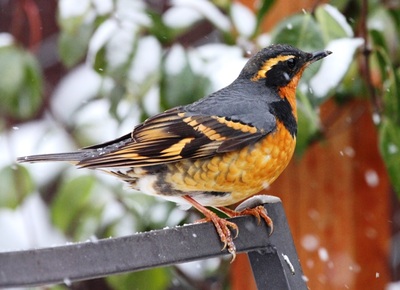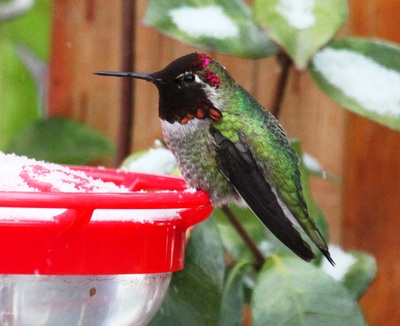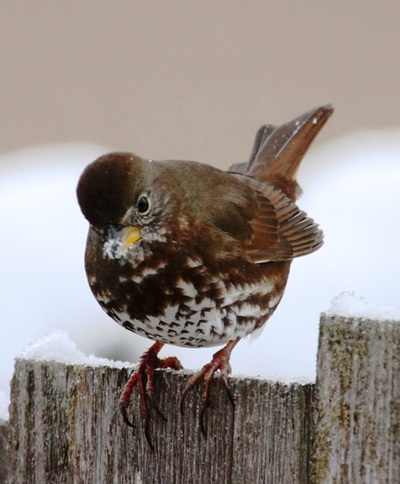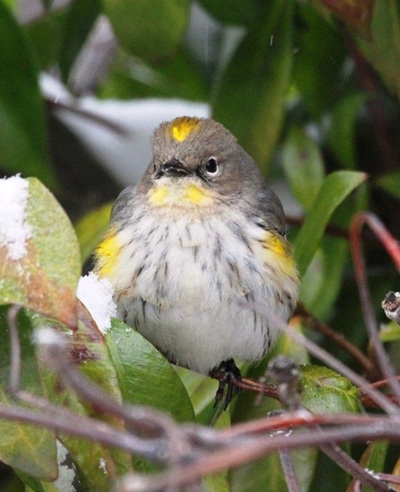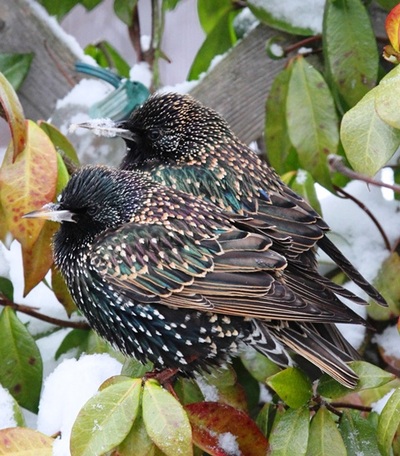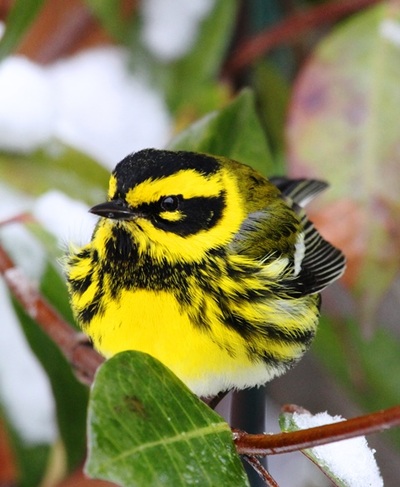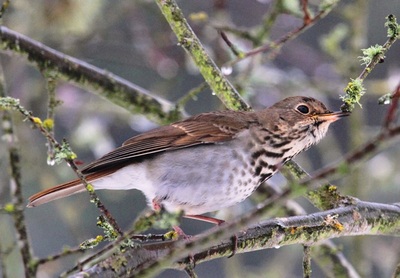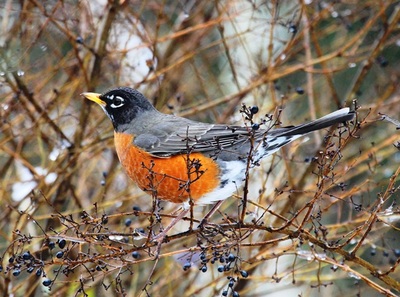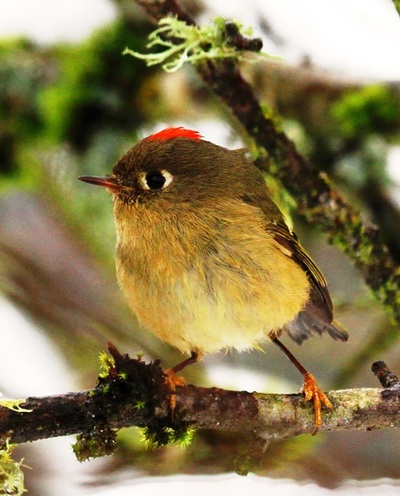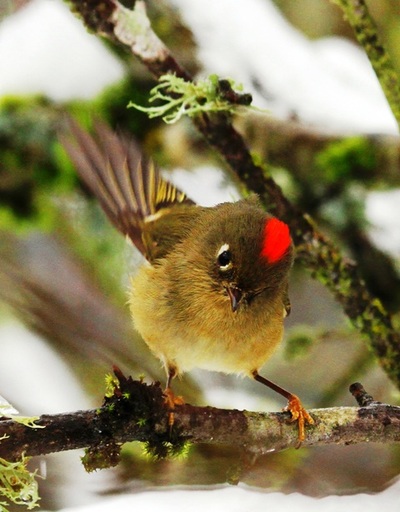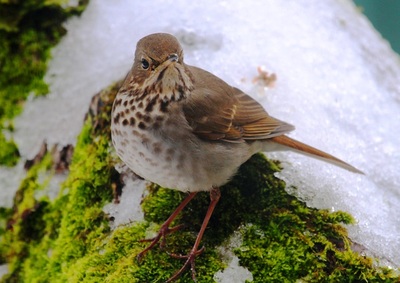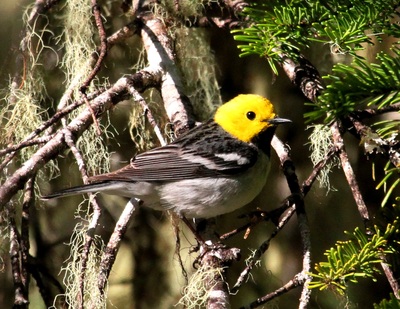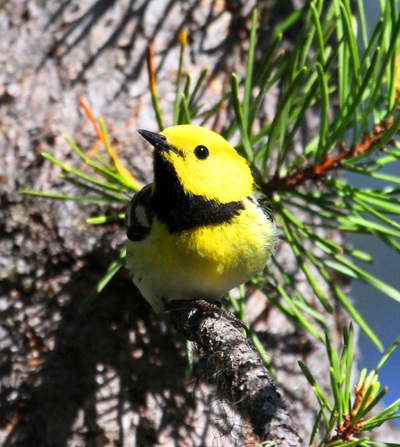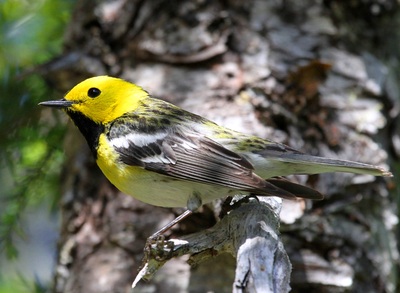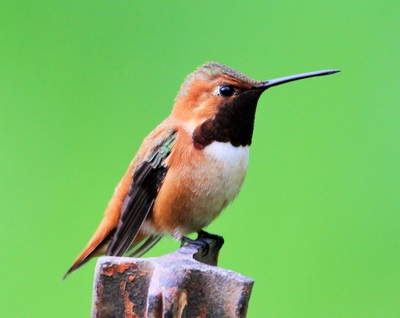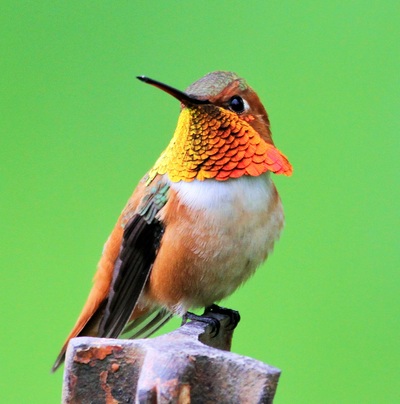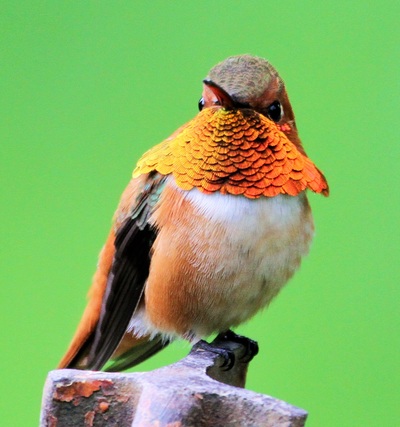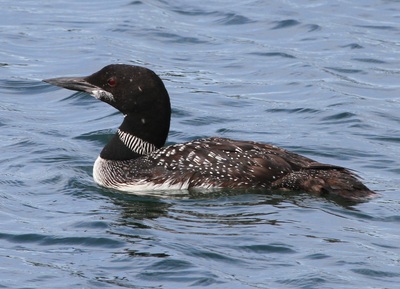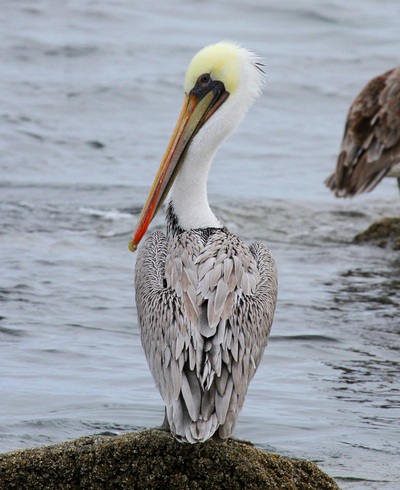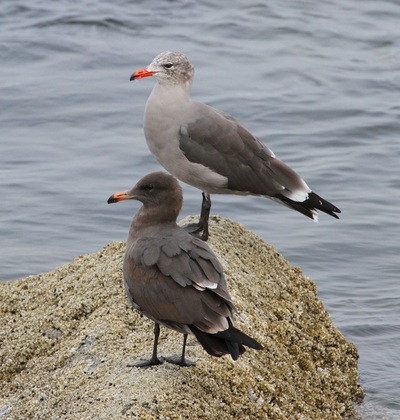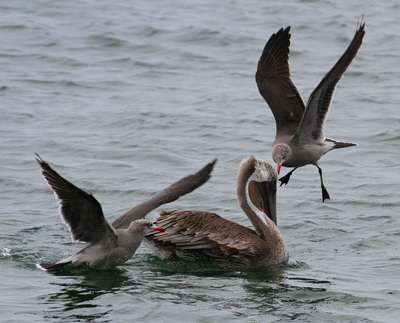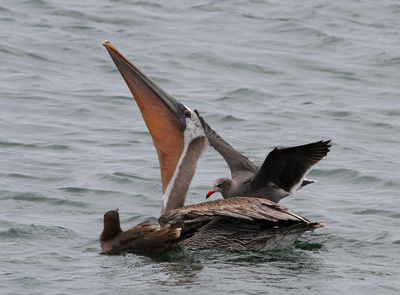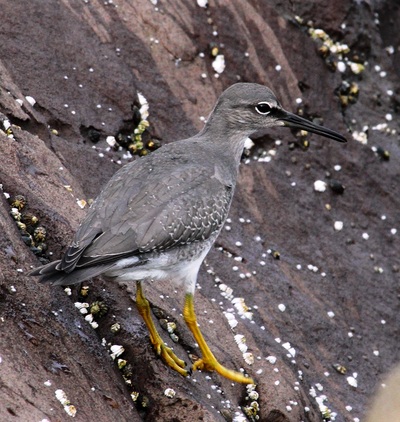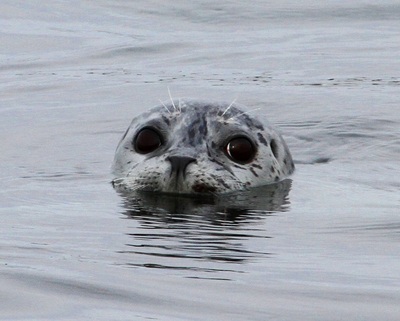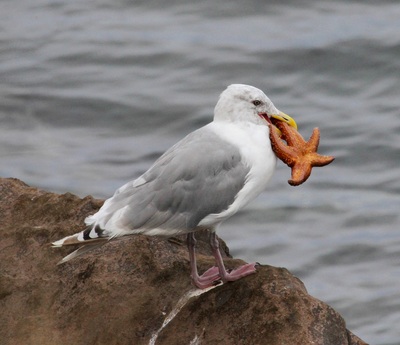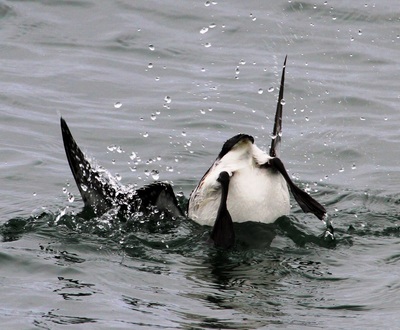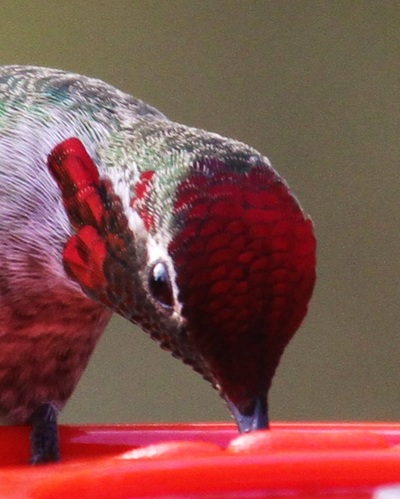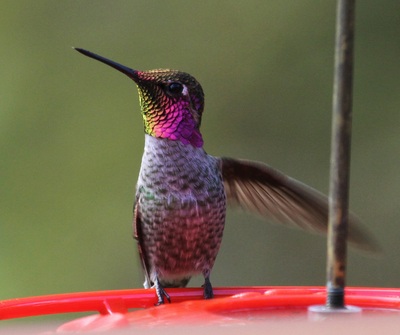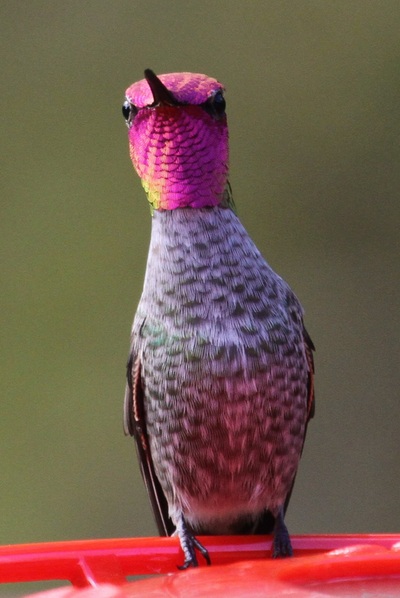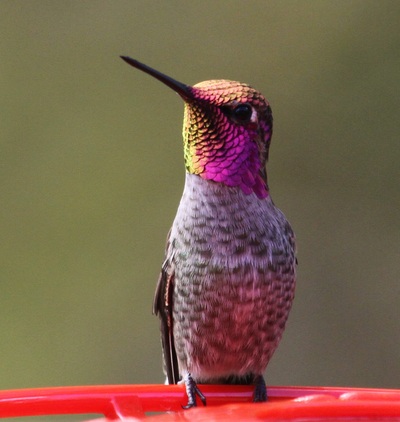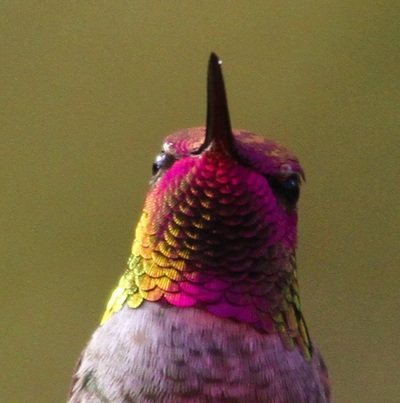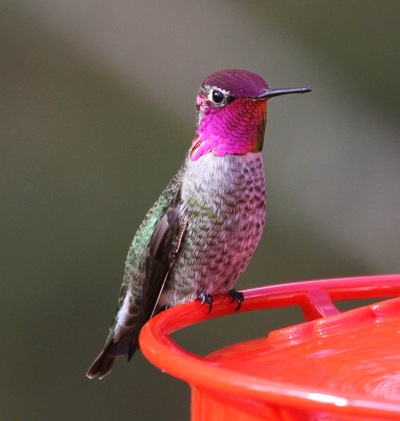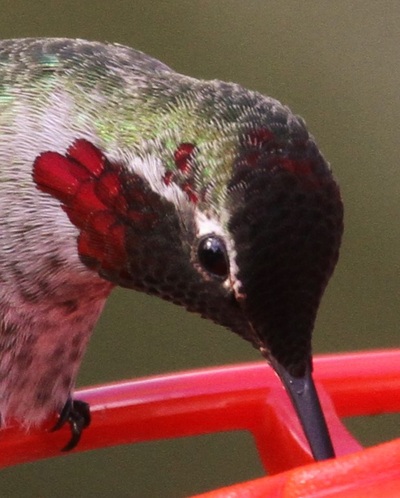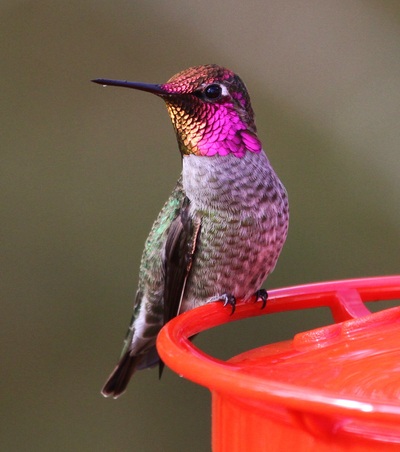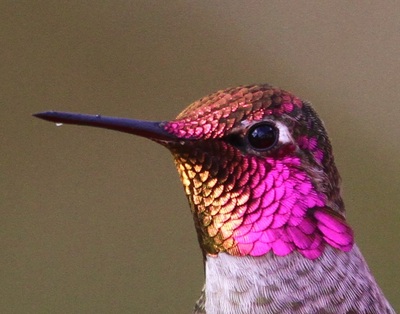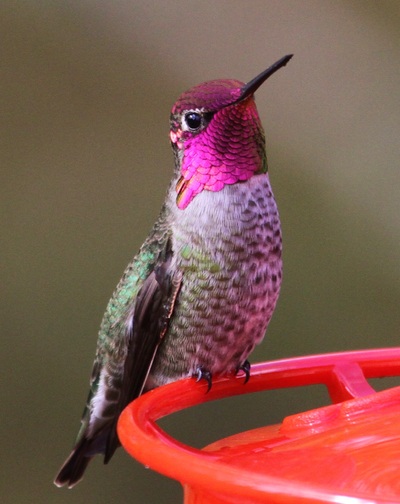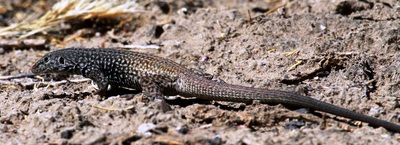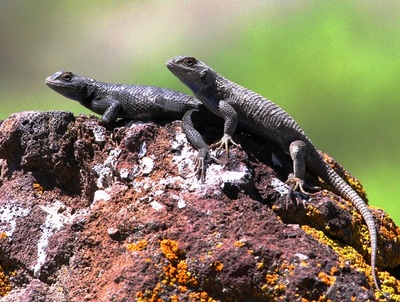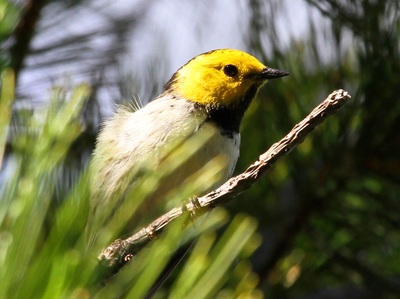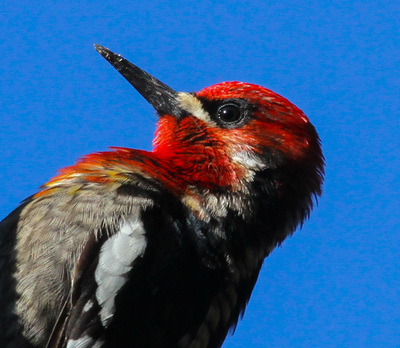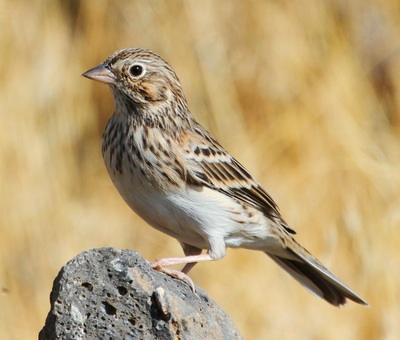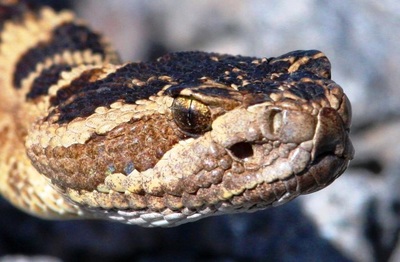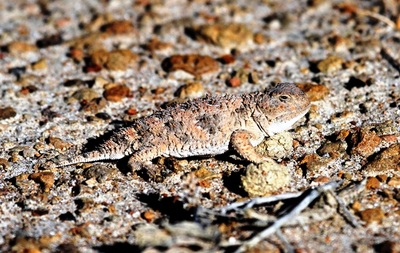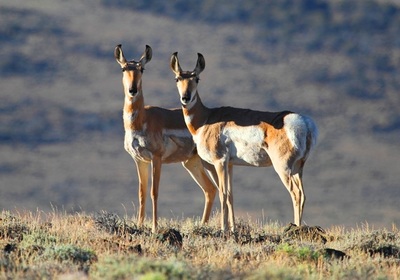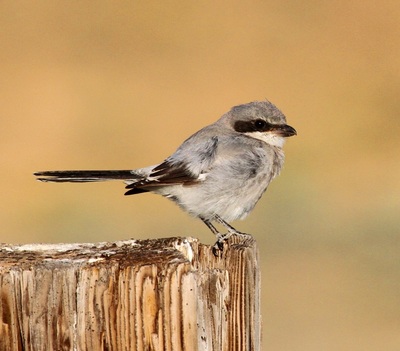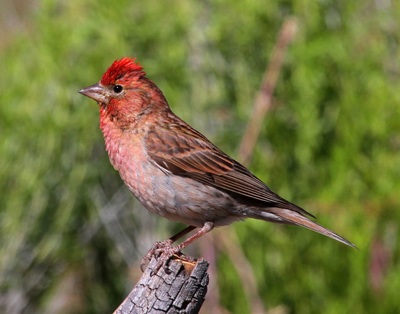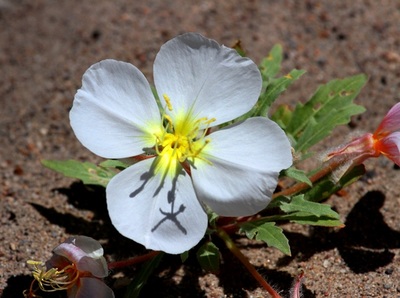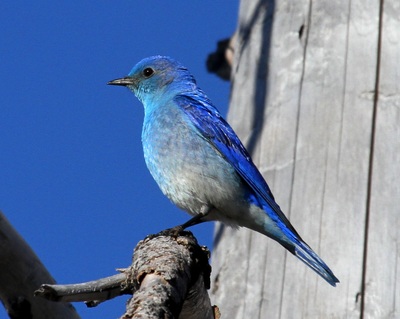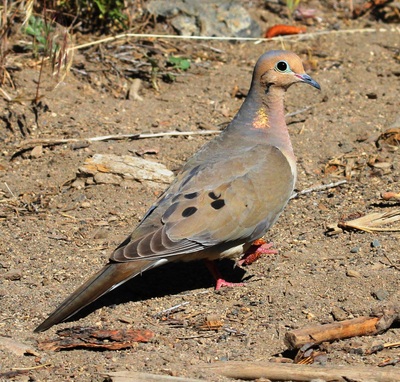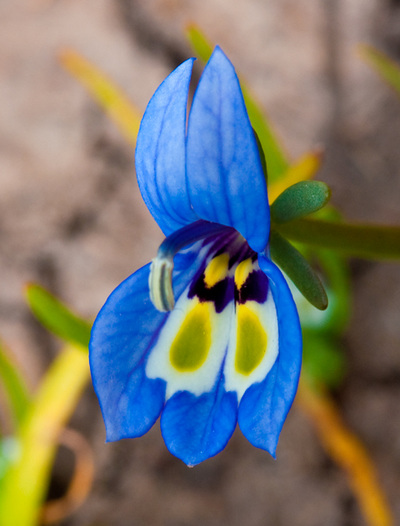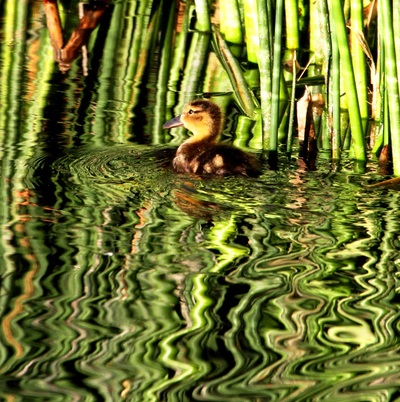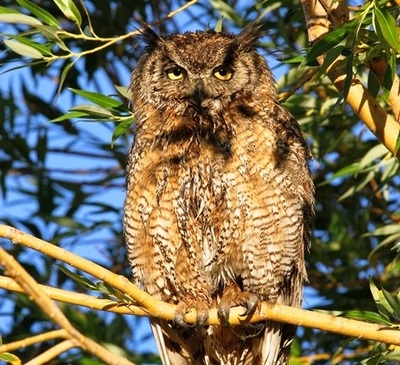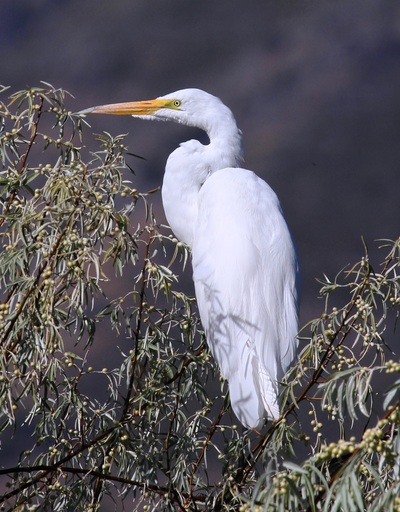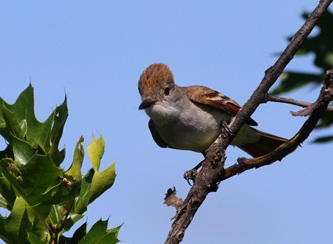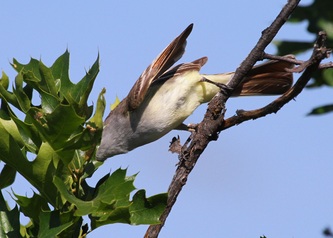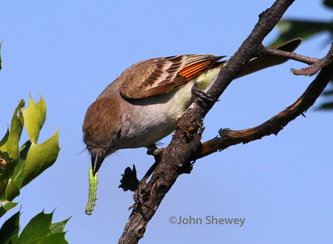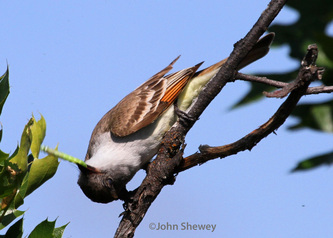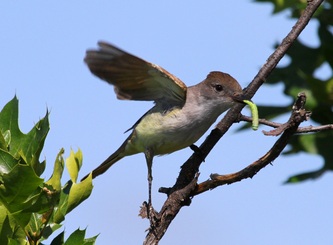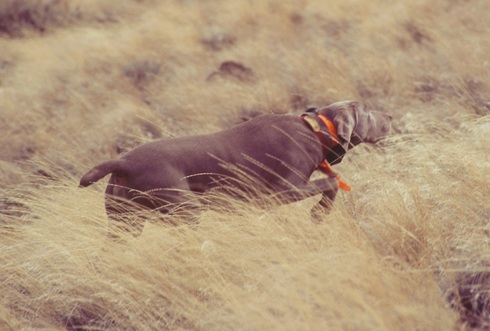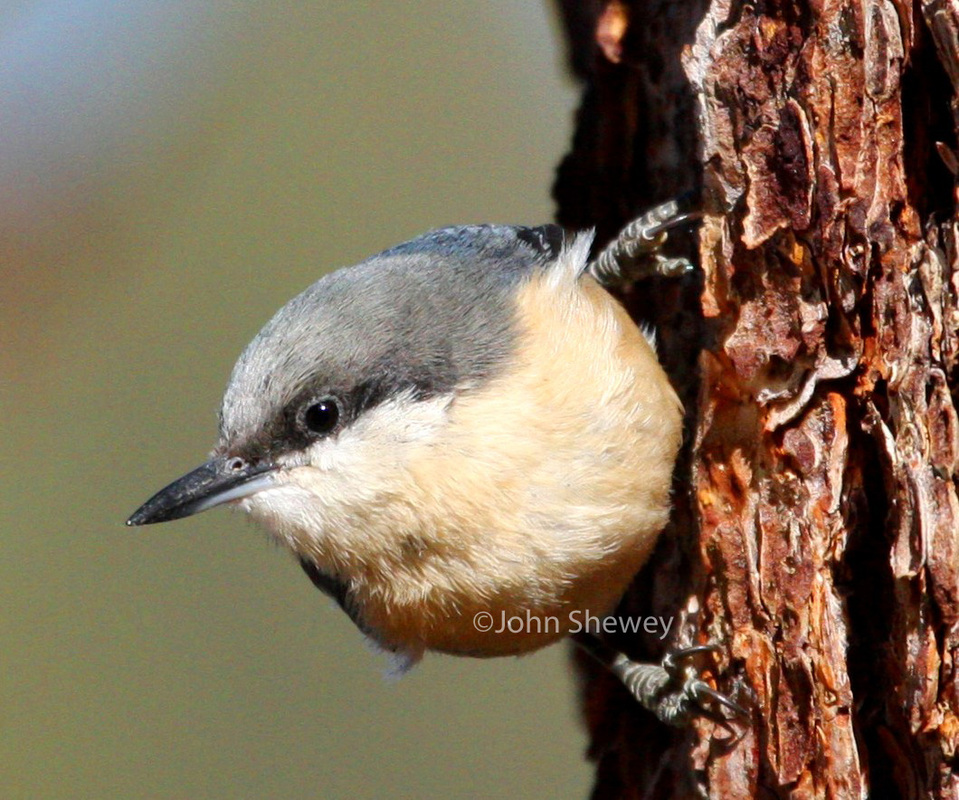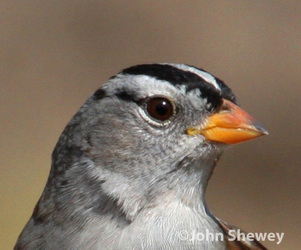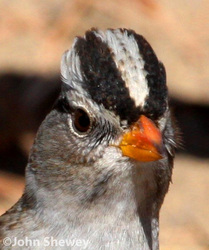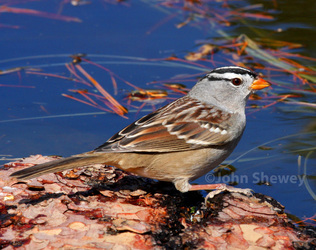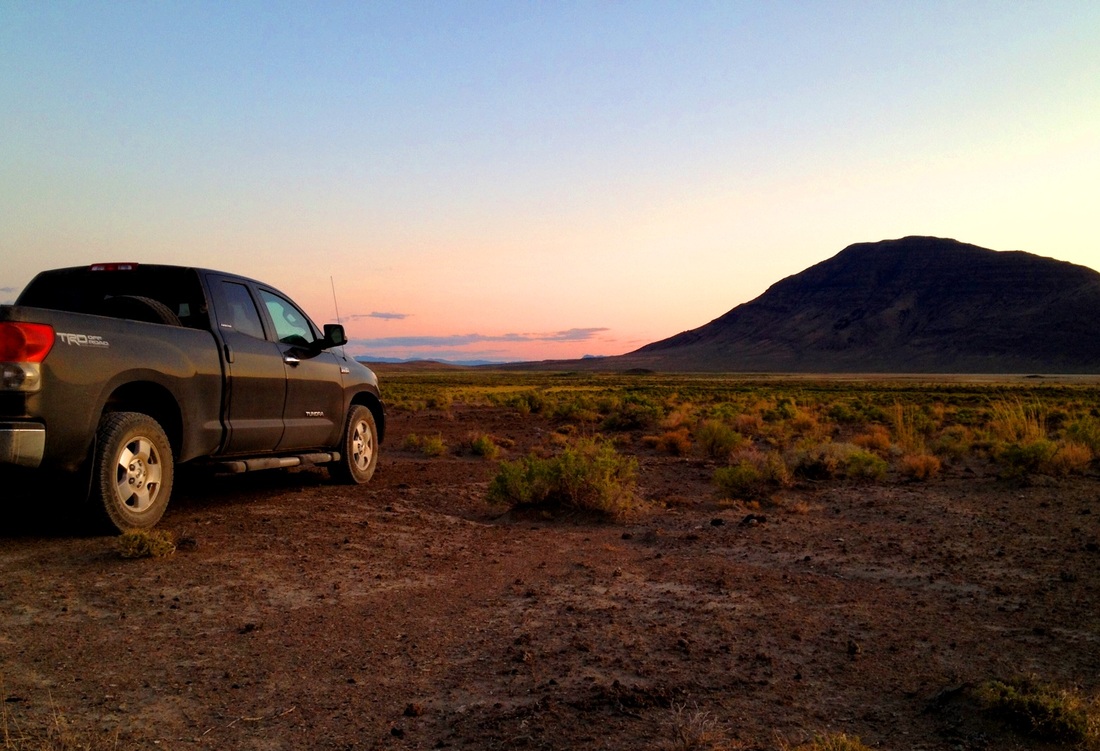|
Ruby-throated Hummingbird in Oregon!
On the morning of June 1, 2012, myself and Tim Blount (www.harneybirder.com) pulled into the headquarters complex at Hart Mountain and immediately noticed plenty of warblers and a few other birds in the adjacent willows and shrubbery. While standing next to the truck identifying warblers—Yellow, Wilson’s, Orange-crowned—we were buzzed by a hummer, a hummer whose flight produced a shrill whine: a Broad-tailed Hummer, always a great find in Oregon. It was a cooperative male that posed several times on what must have been his favorite branch (see home page). Soon we realized there were three or four Broad-tailed Hummers about, but cloudy skies refused to relent for more than brief interludes, making photography challenging. Eventually Tim decided to hike over to a nearby low plateau to check the sagebrush for oddball sparrows and such, but I stayed behind, not wanting to miss out on further chances to photograph the Broad-tailed Hummers. As I stood there camera in hand, patiently waiting for opportunities, the sun popped out and as if on cue a male hummer landed on a willow branch off to my right, 10 yards from where I had been photographing the first male we had seen. I walked very slowly to within range and started firing off shots as fast as I could. Through the lens this bird looked different: his gorget appeared more orange-red than rosy red like the Broad-tailed, and I got fairly excited. But he soon vanished. Tim returned. I described the scene. Tim got equally excited and then, briefly, the bird reappeared and landed on the willow tree, but buzzed off again just as Tim lifted his binoculars. We looked at the photos on my camera, but a 2-inch screen is tough. We tried to convince ourselves it was a Broad-tailed whose gorget looked different because of different light; but we were never really convinced of that and we strongly suspected we'd found a very unlikely Ruby-throated Hummer. When I finally took the time to weed through all those photos on the big screen of my laptop and saw the bird's distinctive forked tail, I realized that what Tim and I suspected was in fact the case: I had photographed a Ruby-throated Hummingbird in Oregon. This was only the third record of this species for Oregon accepted by the Oregon Birds Records Committee . |
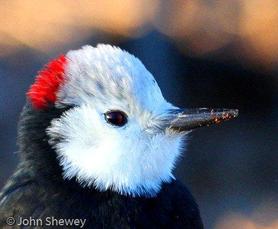
Oregon's 12 Woodpeckers
I realized recently that without actually trying to do so, I managed to see all 12 of Oregon's woodpeckers in 2012 (I'm not including the Nuttall's Woodpecker and Yellow-bellied Sapsucker). Unfortunately I was not able to photograph all 12 species. I don't really have a favorite--they are all fun to watch given their gregarious natures--but I spent a lot of time in the Metolius Basin this spring working on woodpecker photography, and in particular White-headed Woodpecker photography. They have the most limited range of the 12 species in question here, yet because they are closely tied to the ponderosa pine forest belt of Central Oregon, they are common there. They are among the most photographer-friendly of woodpeckers because they habitually forage low on the tree trunks and even on the ground. Still, as with most bird photography, getting great shots requires long hours sitting and standing and waiting, or unadulterated good luck!
I realized recently that without actually trying to do so, I managed to see all 12 of Oregon's woodpeckers in 2012 (I'm not including the Nuttall's Woodpecker and Yellow-bellied Sapsucker). Unfortunately I was not able to photograph all 12 species. I don't really have a favorite--they are all fun to watch given their gregarious natures--but I spent a lot of time in the Metolius Basin this spring working on woodpecker photography, and in particular White-headed Woodpecker photography. They have the most limited range of the 12 species in question here, yet because they are closely tied to the ponderosa pine forest belt of Central Oregon, they are common there. They are among the most photographer-friendly of woodpeckers because they habitually forage low on the tree trunks and even on the ground. Still, as with most bird photography, getting great shots requires long hours sitting and standing and waiting, or unadulterated good luck!
A February Day at Ankeny NWR
Xenophobic Canada Geese
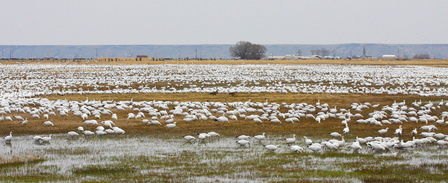
Click on Photo to Enlarge
Last April, Tim Blount and I watched with great interest and amusement as two Canada Geese defended a large circle of feeding territory from any and all incursion by thousands of Ross's and Snow Geese. The Honkers had some predetermined border in mind and any white goose that crossed the invisible line was instantly charged and often attacked by a Honker. So long as the white geese did not violate the invisible borders of this circular kingdom, the two Canada Geese went about their business. Thereby the two Canada Geese maintained, by force, the large circle they had carved out amid all the white geese.
Acty Mountain area, southern Harney County (May)
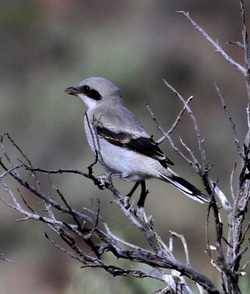
juvenile Loggerhead Shrike
Late June in one of Oregon's remote desert basins.....
Have not had time to really go through my photography from a late-June adventure into one of Oregon's most remote places. The trip produced lots of the usual birds for that area. This was a scouting trip for what hope will be a May trip next year to find out if anything unusual in the way of migrants shows up at some VERY remote springs reachable by way of a boot-busting hike into the mountains above the basin. Timing of the June trip was ideal to see lots of juvenile birds, such as this young shrike.
Have not had time to really go through my photography from a late-June adventure into one of Oregon's most remote places. The trip produced lots of the usual birds for that area. This was a scouting trip for what hope will be a May trip next year to find out if anything unusual in the way of migrants shows up at some VERY remote springs reachable by way of a boot-busting hike into the mountains above the basin. Timing of the June trip was ideal to see lots of juvenile birds, such as this young shrike.
Upper Table Rock in southern Oregon (May)
February Storm Birds in the Willamette Valley
Hermit Warblers....early to mid-June is prime time to get great views of Hermit Warblers up high in the Cascades because the males are singing like crazy and fighting for mates and territories, so they spend plenty of time low in the forest canopy, whereas later in the summer they tend to stay higher in the trees. these guys were photographed at the Maxwell Butte Sno-Park, which was loaded with the little buggers this week (6/11).
Male Rufous Hummingbird
Yaquina Bay South Jetty, Late September
November Male Anna's Hummingbird--About as Perfect as They Get!
Southeast Oregon Trip, early July, 2016
Ash-throated Flycatcher on the hunt--in the 5th photo in the sequence the bird is violently beating the caterpillar against the tree limb to kill it....or perhaps to tenderize it! (Upper Table Rock, Jackson County). Click the first photo and then scroll through the series with the arrow on the right edge of the photos.
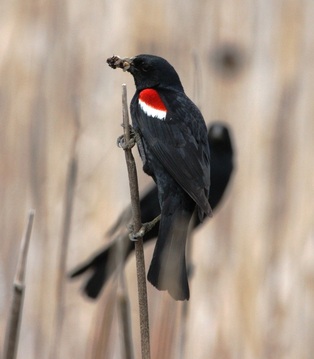
Tri-colored Blackbirds in Central Oregon
As many Oregon birders know, Central Oregon (in the Prineville area) is home to some of the northernmost breeding colonies of Tri-colored Blackbirds. Last May 31, I was watching a colony of them over there and noticed that most all the noisy, gregarious males had gobs of what appeared to be some kind of larvae, balled in mud, in their bills. The females were up on the reed stalks as well. At the time I wondered if perhaps this was some kind of courtship ritual. I consulted Chuck Gates, well-known Central Oregon birding enthusiast, along with a couple research ornithologists specializing in Icterids, Paul Narguizian (Cal State LA) and Alvaro Jaramillo, www.alvarosadventures.com. All three agreed that likely this behavior was simply males bringing food to the nest, with the appearance of something more owing to particular habits of these birds.
Alvaro told me, “Tricolored Blackbirds are highly specialized birds, particularly in their colonial breeding style and the way in which they synchronize everything
they do in life. The classic courtship, or “mate acquisition” display is to sing and show off the epaulets. Tricoloreds are not territorial in the way that Redwings are. What you saw I think is the birds bringing back food to the nest….It likely looked like a parade because the males went foraging together and came back together with similar food; this is classic of Tricolored, they do everything in groups it seems. May 31 does not seem early to me for young to be out, blackbirds tend to breed relatively early and I would expect young at the nest by then.”
Chuck had told me, “I too have seen males behaving in this manner. The literature does not mention this as a courting behavior and I suspect it is simply males returning from foraging trips with food for the young. These guys are notorious for their short breeding season. They court, breed, brood, and fledge in just about three weeks so the courting is short and sweet.”
Paul agreed, and also added, “…referring to specific dates (i.e May 31st) can be tricky since current data shows that Tri-colored Blackbird breeding dates are beginning increasingly earlier (possible due to climate change).”
As many Oregon birders know, Central Oregon (in the Prineville area) is home to some of the northernmost breeding colonies of Tri-colored Blackbirds. Last May 31, I was watching a colony of them over there and noticed that most all the noisy, gregarious males had gobs of what appeared to be some kind of larvae, balled in mud, in their bills. The females were up on the reed stalks as well. At the time I wondered if perhaps this was some kind of courtship ritual. I consulted Chuck Gates, well-known Central Oregon birding enthusiast, along with a couple research ornithologists specializing in Icterids, Paul Narguizian (Cal State LA) and Alvaro Jaramillo, www.alvarosadventures.com. All three agreed that likely this behavior was simply males bringing food to the nest, with the appearance of something more owing to particular habits of these birds.
Alvaro told me, “Tricolored Blackbirds are highly specialized birds, particularly in their colonial breeding style and the way in which they synchronize everything
they do in life. The classic courtship, or “mate acquisition” display is to sing and show off the epaulets. Tricoloreds are not territorial in the way that Redwings are. What you saw I think is the birds bringing back food to the nest….It likely looked like a parade because the males went foraging together and came back together with similar food; this is classic of Tricolored, they do everything in groups it seems. May 31 does not seem early to me for young to be out, blackbirds tend to breed relatively early and I would expect young at the nest by then.”
Chuck had told me, “I too have seen males behaving in this manner. The literature does not mention this as a courting behavior and I suspect it is simply males returning from foraging trips with food for the young. These guys are notorious for their short breeding season. They court, breed, brood, and fledge in just about three weeks so the courting is short and sweet.”
Paul agreed, and also added, “…referring to specific dates (i.e May 31st) can be tricky since current data shows that Tri-colored Blackbird breeding dates are beginning increasingly earlier (possible due to climate change).”
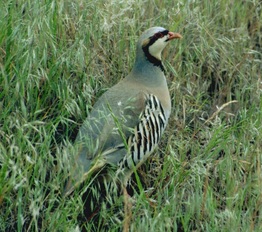
Photo courtesy BLM
Chukars in Winter
I was talking with Tim Blount (Harneybirder.com) the other day, after he had participated in the Christmas Bird Count in Harney County, and the subject of chukars came up; Tim told me no chukars were seen during the count. I don’t find that at all surprising. In fact I would expect that in most years, chukars will be under-reported in a December bird count just about anywhere in their range in Oregon. It has everything to do with their winter habitat preference and habits.
When birders see chukars in eastern Oregon, they usually see them between mid- to late-spring and early autumn—the time when two important factors coincide: that’s when most birders visit eastern Oregon and that’s also when chukars are most easily seen. Chukars need water. So from summer through early- or mid-autumn, they don’t wander far from water sources, which often are found beneath the steep slopes on which chukars feed and nest. At the warmest times of year, chukars tend to visit water twice per day, descending (flying) to water during the morning and the feeding their way back upslope, then loafing and dustbathing, then descending to water again during late afternoon or early evening. When you encounter a covey of chukars right along the road during summer, you’ve no doubt caught them heading to or from water.
Everything changes come winter. Depending on the timing of the arrival of moisture-bearing cold weather, chukars shift their entire lifestyle to the higher-elevation components of their range. During spring, summer, and early fall, chukars frequent north-facing slopes, which are cooler and moister than south-facing slopes—but this seasonal preference switches come winter, when chukars seek warmth. They move high onto south-facing slopes, where they roost at the base of rimrocks, in the rimrocks, and within steep scree fields, because these places are bathed in sunlight and the rocks provide convection; moreover, the top edges of these south facing slopes get sun exposure earlier and later in the day than the lower slopes. The chukars’ preference for south exposures during winter is consistent and highly predictable. At this time, the birds often feed on the very top of those south-exposure ridges during the day and then return to the roosting sites in the later afternoon. This pattern is disrupted only by weather: heavy snow forces the birds to move (more on that in a moment). In addition to finding more warmth on south exposures, chukars also find another critical component to their winter regime: winter green-up.
Winter green-up is a term chukar hunters use in reference to the sprouting of cheat-grass during winter, and cheat-grass is a critical component in the diet of chukars. During most (but not all) winters, warm winter weather as early as December can cause cheat-grass to sprout (warm is a subjective term in this case). The sprouts are tiny; you have to look for them—and know where to look for them. But chukars feed readily on these sprouts, which not coincidentally occur only on the warm south exposures at this time. Exceptionally dry years and bitter-cold years can result in no winter green-up.
Heavy snow is hard on chukars. However, in many instances, those south exposures are the saving graces, as they remain snow-free even when everything else is buried, and of course snow on south exposures melts far more quickly than snow elsewhere. Moreover, wind helps clear snow from high ridges, while it simply piles up at lower elevations. Most birders, understandably, don’t spend a lot of time driving around southeastern Oregon in December and January, but if they did, they would often find those key high south exposures easy to identify from a distance simply by their lack of snow. If you do in fact find yourself driving around chukar country in winter, look up high—look for the uppermost slopes bathed in sunlight and free of snow. That’s where chukars live during winter.
However, as I said, heavy snow changes everything. If snow blankets the countryside, covering the ground deep enough so that chukars cannot feed, the birds will soon need to adjust their pattern, which often means descending to valley floors in hopes of finding some way to feed. At these times, conscientious wingshooters simply abandon the pursuit of chukars in deference to the rules of fair chase—the birds are struggling just to survive. Likewise at this time, it’s not uncommon to see chukars along the highways and roads running beneath their normal steep haunts.
Finally, another factor plays into the difficulty of seeing chukars during winter. Chukars react to hunting pressure by changing their behaviors. They learn to “flush wild” or “flush long,” wingshooter-speak for birds that take to the air far out of shotgun range; and they also learn to hold very tight and then run, rather than fly, in the presence of hunting dogs. On the steep slopes, chukars always run uphill—never down. Conversely, their normal escape flight is hard down and away; uphill flight is exceedingly rare except when birds have flushed from above, wrapped around a shoulder on the slope, and then glided in for an uphill landing on the other side of that landscape feature. When encountered on the flats atop the ridges and rims (where they often feed during winter), chukars that have been hunted become track stars. The bottom line in all cases is that chukars that have been hunted will rarely show themselves for a human not accompanied by a bird dog—without a dog, you can easily and frequently walk right by coveys of chukar and never know they are there.
Pursuing chukars in winter behind pointing dogs teaches you a lot about chukar habits and habitat, or at least it better if you intend to put the dogs in a position to be successful. I’ve done this for 25 years and two things I’ve come firmly to believe with regard to chukars in December and January. The first is easy: trust in those high south slopes. The second is all too easy to forget: always trust the dog’s nose! And those two caveats testify to why chukars are generally going to be underreported in a December bird count.
I was talking with Tim Blount (Harneybirder.com) the other day, after he had participated in the Christmas Bird Count in Harney County, and the subject of chukars came up; Tim told me no chukars were seen during the count. I don’t find that at all surprising. In fact I would expect that in most years, chukars will be under-reported in a December bird count just about anywhere in their range in Oregon. It has everything to do with their winter habitat preference and habits.
When birders see chukars in eastern Oregon, they usually see them between mid- to late-spring and early autumn—the time when two important factors coincide: that’s when most birders visit eastern Oregon and that’s also when chukars are most easily seen. Chukars need water. So from summer through early- or mid-autumn, they don’t wander far from water sources, which often are found beneath the steep slopes on which chukars feed and nest. At the warmest times of year, chukars tend to visit water twice per day, descending (flying) to water during the morning and the feeding their way back upslope, then loafing and dustbathing, then descending to water again during late afternoon or early evening. When you encounter a covey of chukars right along the road during summer, you’ve no doubt caught them heading to or from water.
Everything changes come winter. Depending on the timing of the arrival of moisture-bearing cold weather, chukars shift their entire lifestyle to the higher-elevation components of their range. During spring, summer, and early fall, chukars frequent north-facing slopes, which are cooler and moister than south-facing slopes—but this seasonal preference switches come winter, when chukars seek warmth. They move high onto south-facing slopes, where they roost at the base of rimrocks, in the rimrocks, and within steep scree fields, because these places are bathed in sunlight and the rocks provide convection; moreover, the top edges of these south facing slopes get sun exposure earlier and later in the day than the lower slopes. The chukars’ preference for south exposures during winter is consistent and highly predictable. At this time, the birds often feed on the very top of those south-exposure ridges during the day and then return to the roosting sites in the later afternoon. This pattern is disrupted only by weather: heavy snow forces the birds to move (more on that in a moment). In addition to finding more warmth on south exposures, chukars also find another critical component to their winter regime: winter green-up.
Winter green-up is a term chukar hunters use in reference to the sprouting of cheat-grass during winter, and cheat-grass is a critical component in the diet of chukars. During most (but not all) winters, warm winter weather as early as December can cause cheat-grass to sprout (warm is a subjective term in this case). The sprouts are tiny; you have to look for them—and know where to look for them. But chukars feed readily on these sprouts, which not coincidentally occur only on the warm south exposures at this time. Exceptionally dry years and bitter-cold years can result in no winter green-up.
Heavy snow is hard on chukars. However, in many instances, those south exposures are the saving graces, as they remain snow-free even when everything else is buried, and of course snow on south exposures melts far more quickly than snow elsewhere. Moreover, wind helps clear snow from high ridges, while it simply piles up at lower elevations. Most birders, understandably, don’t spend a lot of time driving around southeastern Oregon in December and January, but if they did, they would often find those key high south exposures easy to identify from a distance simply by their lack of snow. If you do in fact find yourself driving around chukar country in winter, look up high—look for the uppermost slopes bathed in sunlight and free of snow. That’s where chukars live during winter.
However, as I said, heavy snow changes everything. If snow blankets the countryside, covering the ground deep enough so that chukars cannot feed, the birds will soon need to adjust their pattern, which often means descending to valley floors in hopes of finding some way to feed. At these times, conscientious wingshooters simply abandon the pursuit of chukars in deference to the rules of fair chase—the birds are struggling just to survive. Likewise at this time, it’s not uncommon to see chukars along the highways and roads running beneath their normal steep haunts.
Finally, another factor plays into the difficulty of seeing chukars during winter. Chukars react to hunting pressure by changing their behaviors. They learn to “flush wild” or “flush long,” wingshooter-speak for birds that take to the air far out of shotgun range; and they also learn to hold very tight and then run, rather than fly, in the presence of hunting dogs. On the steep slopes, chukars always run uphill—never down. Conversely, their normal escape flight is hard down and away; uphill flight is exceedingly rare except when birds have flushed from above, wrapped around a shoulder on the slope, and then glided in for an uphill landing on the other side of that landscape feature. When encountered on the flats atop the ridges and rims (where they often feed during winter), chukars that have been hunted become track stars. The bottom line in all cases is that chukars that have been hunted will rarely show themselves for a human not accompanied by a bird dog—without a dog, you can easily and frequently walk right by coveys of chukar and never know they are there.
Pursuing chukars in winter behind pointing dogs teaches you a lot about chukar habits and habitat, or at least it better if you intend to put the dogs in a position to be successful. I’ve done this for 25 years and two things I’ve come firmly to believe with regard to chukars in December and January. The first is easy: trust in those high south slopes. The second is all too easy to forget: always trust the dog’s nose! And those two caveats testify to why chukars are generally going to be underreported in a December bird count.
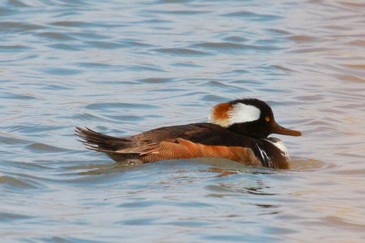
What's the Deal with this Hoody?
An oddball plumage like this might not raise many eyebrows post-breeding season, but I photographed this drake in early April (April 6, 2012, to be exact) at Dufurrena Ponds in northern Nevada (a locale emphatically lacking in nesting holes for cavity-nesting ducks), so I’m a tad curious about this bird. Clearly this is a pre-breeding season drake carrying a strange plumage at the exact time when ducks are at their resplendent best; he was flocked with three hens and no doubt on the way northerly to more suitable breeding habitat. If any waterfowl experts have an opinion, feel free to email me through my contact page.
An oddball plumage like this might not raise many eyebrows post-breeding season, but I photographed this drake in early April (April 6, 2012, to be exact) at Dufurrena Ponds in northern Nevada (a locale emphatically lacking in nesting holes for cavity-nesting ducks), so I’m a tad curious about this bird. Clearly this is a pre-breeding season drake carrying a strange plumage at the exact time when ducks are at their resplendent best; he was flocked with three hens and no doubt on the way northerly to more suitable breeding habitat. If any waterfowl experts have an opinion, feel free to email me through my contact page.
Pygmy Nuthatches
|
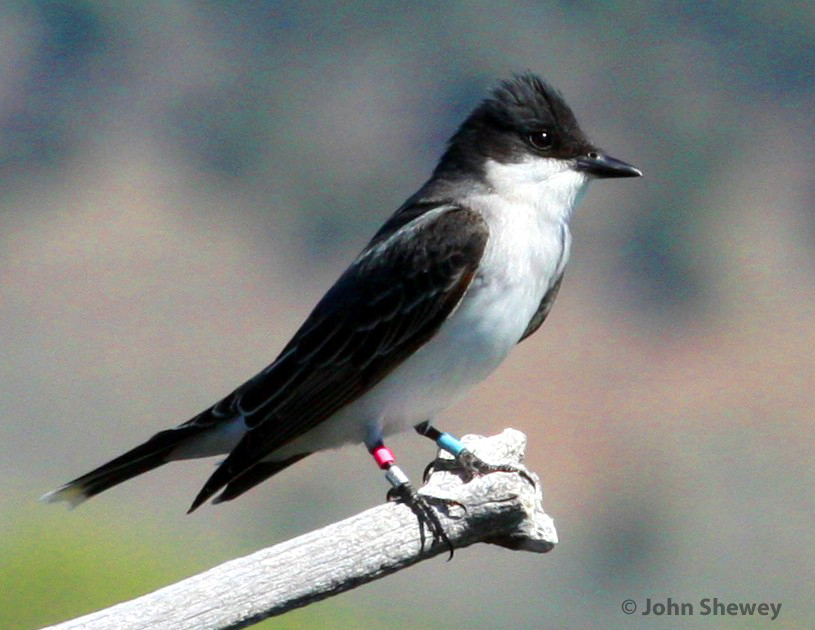
Check out the leg bands on this Eastern Kingbird: this bird was part of a study (2004-2007) on Malhuer NWR. The paper, with an abstract, is here: www.springerlink.com/content/6q07j68801826122/
Note that this bird was photographed in 2012, so it is an old-timer among Eastern Kingbirds (see this great species profile that says some eastern kingbirds have been known to live 7 years: http://faculty.ncwc.edu/mbrooks/pif/bird%20profiles/eastern_kingbird.htm).
